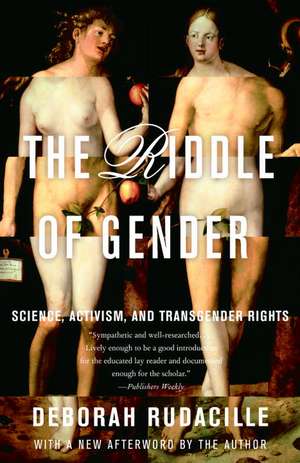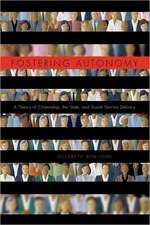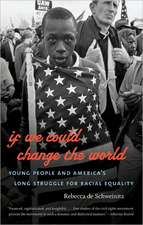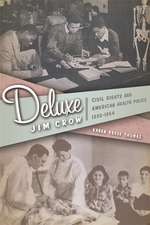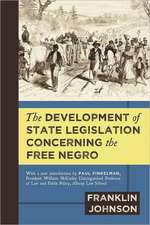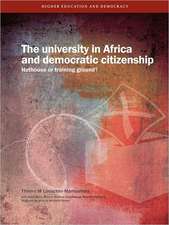The Riddle of Gender: Science, Activism, and Transgender Rights
Autor Deborah Rudacilleen Limba Engleză Paperback – 31 ian 2006
Vezi toate premiile Carte premiată
Lambda Literary Awards (2005)
Coming at the controversial subject of transsexualism from several angles–historical, sociological, psychological, medical–Rudacille discovered that gender variance is anything but new, that changing one’s gender has been met with both acceptance and hostility through the years, and that gender identity, like sexual orientation, appears to be inborn, not learned, though in some people the sex of the body does not match the sex of the brain.
Informed not only by meticulous research, but also by the author’s interviews with prominent members of the transgender community, The Riddle of Gender is a sympathetic and wise look at a sexual revolution that calls into question many of our most deeply held assumptions about what it means to be a man, a woman, and a human being.
Preț: 114.97 lei
Nou
Puncte Express: 172
Preț estimativ în valută:
20.34€ • 23.86$ • 17.87£
20.34€ • 23.86$ • 17.87£
Carte disponibilă
Livrare economică 14-28 ianuarie 26
Preluare comenzi: 021 569.72.76
Specificații
ISBN-13: 9780385721974
ISBN-10: 0385721978
Pagini: 369
Dimensiuni: 134 x 205 x 22 mm
Greutate: 0.3 kg
Editura: Anchor Books
ISBN-10: 0385721978
Pagini: 369
Dimensiuni: 134 x 205 x 22 mm
Greutate: 0.3 kg
Editura: Anchor Books
Notă biografică
Deborah Rudacille is a science writer at Johns Hopkins University. She is the author of The Scalpel and the Butterfly: The Conflict Between Animal Research and Animal Protection. She lives in Baltimore.
Extras
One
THE HANDS OF GOD
I began the research for this book in the way that I approach every scientific subject that interests me, by searching the literature. I soon discovered that far from being a product of the modern world, gender variance has been documented across cultures and in every epoch of history. Male-bodied persons dressing and living as women and female-bodied persons dressing and living as men were known in ancient Greece and Rome, among Native American tribes prior to the arrival of Europeans, on the Indian subcontinent, in Africa, in Siberia, in Eastern Europe, and in nearly every other indigenous society studied by anthropologists. According to historian Vern Bullough, "gender crossing is so ubiquitous, that genitalia by itself has never been a universal nor essential insignia of a lifelong gender." In some of these cultures, cross-gendered persons were considered shamans gifted with extraordinary psychic powers, and they assumed special ceremonial roles. In many religions, the gods themselves can transform their sex at will, cross-dress, or are androgynous. Our Judeo-Christian heritage, founded on a belief in an exclusively male deity, has frowned on such gender fluidity; nonetheless, throughout the Middle Ages and even into the modern era, cross-dressing has been permitted and indeed celebrated at festivals, in clubs, and on the stage.
Moreover, the deathbed discovery of a gender reversal is a far more common occurrence in Western history than one might suspect. Many (though not all) of the persons whose names and stories are known to us today were born female and lived some or all of their lives as men. A few of the better-known individuals in this category include James Barry, British army physician and Inspector-General, died 1865; Charles Durkee Pankhurst, California stagecoach driver, died 1879; Murray Hall, Tammany Hall politician, died 1901; Jack Bee Garland, soldier in the Spanish-American War, died 1936; and Billy Tipton, jazz trumpeter, died 1989. Some of these people were married to women, who publicly expressed shock and amazement when their partners died and were found to be other than what friends and neighbors assumed them to be. It is impossible to know if this shock was real or was feigned for the benefit of a public that was not prepared to accept the alternative explanation--that the widow had lived happily with a female-bodied person who saw himself and was accepted by others (including his wife) as a man. The case of the Chevalier d'Eon, an eighteenth-century aristocrat whose gender was a source of considerable controversy during his lifetime, is a bit more complex, and because it became a public scandal, I will recount it more fully here.
Born in France in 1728, Charles-Genevieve Louis-Auguste-Andre-Timothee d'Eon de Beaumont lived forty-nine years as a man and thirty-four as a woman. Aristocrat, diplomat, soldier, and spy, d'Eon worked for the French government in both male and female roles, exhibiting such a chameleon-like ability to change from man to woman and back again that contemporary historians remain just as baffled as d'Eon's peers by the chevalier's metamorphoses. Traditional accounts suggest that d'Eon was dispatched on his first diplomatic mission to Russia in female garb to infiltrate the social circle of the Empress Elizabeth. After successfully carrying out this mission, d'Eon returned to France and assumed an unambiguously male role, becoming a captain of dragoons and fighting valiantly in the Seven Years' War. Wounded in battle, d'Eon was named a Knight of St. Louis, and in 1762 was offered a diplomatic assignment at the British royal court. In a letter, the French king Louis XV congratulated the chevalier on his new post and wrote, "You have served me just as well in women's clothing as you have in the clothes you are now wearing."
While d'Eon was serving as minister plenipotentiary in London, his slight build and pretty features led many to believe that he was in fact a cross-dressed woman. People in England and France began placing wagers on his sex. The London Stock Exchange took bets on his gender, and the amount of money wagered on the chevalier purportedly rose to nearly two hundred thousand pounds in England alone. The fear of kidnapping began to haunt the chevalier, who suspected that those who had wagered large sums of money on the shape of his genitalia might seek to resolve the question by kidnapping and forced exposure. To avert a diplomatic crisis, King Louis XV of France sent a letter to George III of England, stating that d'Eon was a woman. Rather than calming public doubts, this letter created an even greater frenzy. Lawsuits were filed by losing bettors, doctors were called in to testify, and d'Eon was officially declared a woman by an English court. The chevalier responded to this public humiliation with dignity and defiance, writing to a friend, "I am what the hands of God have made me."
In exchange for d'Eon's agreement to live quietly as a woman, the French government granted the chevalier a generous pension. Although agreeing to abandon military dress, d'Eon requested permission to continue wearing the Cross of St. Louis, which as he wrote in a letter to the king "has always been a reward for bravery on the battlefield. Many officers have become priests or politicians and have worn this distinction over their new apparel. Therefore, I do not believe that a brave woman, who was raised in men's clothing by her family, can be denied this right after she has carried out the dangerous duties in a praiseworthy fashion." This request was granted and Mademoiselle d'Eon spent much of the remainder of her life residing in London with a female companion. When d'Eon died in 1810, five men who had known d'Eon were asked to examine the body and record their observations in order to settle definitively the question of d'Eon's sex. All five witnesses testified that the body was anatomically male. The deceased's female companion of many years professed herself shocked to discover that Mademoiselle d'Eon was not the women she had always assumed her to be.
A generation after the Chevalier d'Eon's death, a group of French doctors examined another puzzling corpse--that of a thirty-year-old railroad employee who had committed suicide in a squalid attic room in Paris. Abel Barbin, known for twenty-four years as Adelaide Herculine Barbin (and called Alexina), had been born with a body that appeared female. She was raised in a convent and became a teacher at an all-girl boarding school. Severe pain in her lower abdomen caused Alexina to seek medical assistance while employed at the school. The results of the doctor's examination changed her life forever. "His hand was already slipping under my sheet and coming to a stop at the sensitive place. It pressed upon it several times, as if to find there the solution to a difficult problem. It did not leave off at that point!!! He had found the explanation that he was looking for! But it was easy to see that it exceeded all his expectations!"
The doctor had discovered Alexina's undescended testicles and small penis, though he did not reveal this information to either Alexina or her employer, and instead advised the headmistress of the school to terminate the young schoolmistress. Alexina sought the advice of her bishop, who sent her to a second physician, a researcher, who prepared "a voluminous report, a masterpiece in the medical style, intended to ensure before the courts a petition for rectification." In June 1860, the birth register in Barbin's home district was amended, and the female Alexina became the male Abel--by an act of law, not surgery. Though the body remained the same, the legal person was transformed from female to male. The scandal that ensued when the newspapers and the public discovered that a man had been teaching in an all-girl boarding school condemned Abel to "abandonment, to cold isolation." His life as a man began in pain and confusion and plummeted rapidly into despair. He attempted to make a fresh start in Paris, but, impoverished and alone in a city that granted anonymity if not happiness, Abel was unable to make the transition from convent-bred woman to working man. He committed suicide at the age of thirty, overcome by feelings of isolation and desolation, the sense that he was absolutely alone in the world.
In his journal, Abel predicted that after his death his anomalous body would become a teaching tool and an exemplar of oddity. "When that day comes a few doctors will make a little stir around my corpse; they will shatter all the extinct mechanisms of its impulses, will draw new information from it, will analyze all the mysterious sufferings that were heaped up on a single human being." This premonition was fulfilled as Abel's body was autopsied and the genitals and internal organs probed, studied, and sketched for the edification of future physicians pondering the riddle of "hermaphrodites," individuals whose bodies did not conform to traditional notions of male and female anatomy.
Though the Chevalier d'Eon and Abel Barbin are perhaps the best-known cases of presurgical "sex changes" in Western history, physically intersexual people such as Herculine Barbin and neurologically intersexual people such as the Chevalier d'Eon have always existed. Gender variance thus appears to be a "natural" phenomenon, an example of biological diversity. Professor Milton Diamond of the University of Hawaii, who has studied the phenomenon of intersexuality for more than half a century, argues persuasively that gender variance should be considered neither an anomaly nor a pathology, but a simple variation. "Variety is Nature's way," he told an audience at the International Foundation for Gender Education (IFGE) in March 2003. "How many of us in this room are the same height, weight? We're all part of a great experiment." Unfortunately, society doesn't view gender variance with the same benevolence that it views differences in height and (less benevolently today) weight. "Difference is a dirty word to many," Diamond pointed out.
As contemporary historians and writers have worked to uncover the hidden history of homosexuality, some long-dead individuals who adopted cross-gendered dress and lifestyles have been lauded as gay pioneers. The most famous such case is that of Alan Hart (Nee Alberta Lucille), a Portland physician who began living as a man after a hysterectomy in 1917. The historian Jonathan Ned Katz identified Hart on the basis of a case study published by the physician who oversaw, and encouraged, Hart's metamorphosis. Katz and the larger gay community promptly proclaimed Hart (who was married to a woman) a lesbian pioneer, and explained Hart's decision to live as a man as an accommodation to social prejudices and coercion by a homophobic physician.
Among gays as well as straights, the complex relationship between sexual orientation and gender identity has thus sometimes been reduced to a simple formula with four variables: male or female, gay or straight. This perspective is shared by members of the (straight) public who believe that a man who wears dresses can't possibly be heterosexual, even if he sleeps with women only, just as some gay Americans believe that a female-bodied person who dresses like a man must be a masculine lesbian. Both gays and straights have a hard time believing that both of these individuals might in fact be heterosexual men. That idea challenges everything that we think we know about sex, gender, and sexual orientation. "Some men are born in female bodies," said Katherine (Kit) Rachlin--a clinical psychologist who has worked with transgendered clients for more than fifteen years--at a conference I attended while beginning research on this book. Like many Americans, gay and straight, I received this statement with certain skepticism. But after having met numerous men born in female bodies and women born in male bodies, I no longer doubt that it is true.
Sexual orientation is invisible, but gender identity is difficult to hide. It's evident in the way we walk, the way we talk, the way we dress, the way we cut our hair. My identity as a woman is clearly visible in hundreds of small and large ways. When you pass me on the street, your brain registers my long hair, makeup, skirt, pocketbook, and painted nails, and renders the verdict "female." Even if I cut my hair short, skipped makeup, and wore jeans and a T-shirt, you would still identify me as a woman by my physique, by my gait, and by the way I related to you, my fellow pedestrian, as I walked by. But what if, when you passed me on the street, you felt a moment of confusion? What if you felt it necessary to turn around and stare at me as I walked away from you? What if you turned to your companion and said, "Was that a guy or a girl?" Would you be reacting to sexual orientation or gender expression?
Many people infer the former from the latter, and believe that "masculine" women and "feminine" men are invariably gay. Feminine males and masculine females are often subject to scorn and derision, as anyone who has spent time on a playground can testify. A boy who rejects rough play and sports, who walks or talks in a way considered effeminate by his peers, is verbally and sometimes physically abused. The rules for girls are a bit looser in childhood. But by middle school, girls who are deemed inappropriately masculine by their peers are also teased and harassed. These prejudices carry through into adult life, and the all-purpose word used by many people to enforce gender conformity is "gay"--even when they are referring not to the person's choice of partner, but to the way he or she expresses gender. It is worth noting that though an increasing number of cities and states have added "sexual orientation" to civil rights legislation, fewer have added riders protecting people whose gender expression makes them targets of discrimination or violence. This lapse is a sign of our continuing failure to understand and acknowledge the distinction between sexual orientation and gender identity, and it has major consequences.
Jillian Weiss, an attorney who has published several articles about the legal issues confronting transgendered and transsexual people, notes that "gender identity is subject to scrutiny in a way that sexual identity [orientation] is not." The letter M or F affixed to one's birth certificate "publicly identifies us in every area of life, whether it be a license to drive or conduct business, proof of citizenship required to obtain employment, a benefit program such as social security, or filing of income taxes." Biological sex (and therefore gender identity) is thus regulated by the state in a way that sexual orientation is not. Citizens of the United States and most other nations are not required to announce their sexual orientation or to affirm it in legal documents.
From the Hardcover edition.
THE HANDS OF GOD
I began the research for this book in the way that I approach every scientific subject that interests me, by searching the literature. I soon discovered that far from being a product of the modern world, gender variance has been documented across cultures and in every epoch of history. Male-bodied persons dressing and living as women and female-bodied persons dressing and living as men were known in ancient Greece and Rome, among Native American tribes prior to the arrival of Europeans, on the Indian subcontinent, in Africa, in Siberia, in Eastern Europe, and in nearly every other indigenous society studied by anthropologists. According to historian Vern Bullough, "gender crossing is so ubiquitous, that genitalia by itself has never been a universal nor essential insignia of a lifelong gender." In some of these cultures, cross-gendered persons were considered shamans gifted with extraordinary psychic powers, and they assumed special ceremonial roles. In many religions, the gods themselves can transform their sex at will, cross-dress, or are androgynous. Our Judeo-Christian heritage, founded on a belief in an exclusively male deity, has frowned on such gender fluidity; nonetheless, throughout the Middle Ages and even into the modern era, cross-dressing has been permitted and indeed celebrated at festivals, in clubs, and on the stage.
Moreover, the deathbed discovery of a gender reversal is a far more common occurrence in Western history than one might suspect. Many (though not all) of the persons whose names and stories are known to us today were born female and lived some or all of their lives as men. A few of the better-known individuals in this category include James Barry, British army physician and Inspector-General, died 1865; Charles Durkee Pankhurst, California stagecoach driver, died 1879; Murray Hall, Tammany Hall politician, died 1901; Jack Bee Garland, soldier in the Spanish-American War, died 1936; and Billy Tipton, jazz trumpeter, died 1989. Some of these people were married to women, who publicly expressed shock and amazement when their partners died and were found to be other than what friends and neighbors assumed them to be. It is impossible to know if this shock was real or was feigned for the benefit of a public that was not prepared to accept the alternative explanation--that the widow had lived happily with a female-bodied person who saw himself and was accepted by others (including his wife) as a man. The case of the Chevalier d'Eon, an eighteenth-century aristocrat whose gender was a source of considerable controversy during his lifetime, is a bit more complex, and because it became a public scandal, I will recount it more fully here.
Born in France in 1728, Charles-Genevieve Louis-Auguste-Andre-Timothee d'Eon de Beaumont lived forty-nine years as a man and thirty-four as a woman. Aristocrat, diplomat, soldier, and spy, d'Eon worked for the French government in both male and female roles, exhibiting such a chameleon-like ability to change from man to woman and back again that contemporary historians remain just as baffled as d'Eon's peers by the chevalier's metamorphoses. Traditional accounts suggest that d'Eon was dispatched on his first diplomatic mission to Russia in female garb to infiltrate the social circle of the Empress Elizabeth. After successfully carrying out this mission, d'Eon returned to France and assumed an unambiguously male role, becoming a captain of dragoons and fighting valiantly in the Seven Years' War. Wounded in battle, d'Eon was named a Knight of St. Louis, and in 1762 was offered a diplomatic assignment at the British royal court. In a letter, the French king Louis XV congratulated the chevalier on his new post and wrote, "You have served me just as well in women's clothing as you have in the clothes you are now wearing."
While d'Eon was serving as minister plenipotentiary in London, his slight build and pretty features led many to believe that he was in fact a cross-dressed woman. People in England and France began placing wagers on his sex. The London Stock Exchange took bets on his gender, and the amount of money wagered on the chevalier purportedly rose to nearly two hundred thousand pounds in England alone. The fear of kidnapping began to haunt the chevalier, who suspected that those who had wagered large sums of money on the shape of his genitalia might seek to resolve the question by kidnapping and forced exposure. To avert a diplomatic crisis, King Louis XV of France sent a letter to George III of England, stating that d'Eon was a woman. Rather than calming public doubts, this letter created an even greater frenzy. Lawsuits were filed by losing bettors, doctors were called in to testify, and d'Eon was officially declared a woman by an English court. The chevalier responded to this public humiliation with dignity and defiance, writing to a friend, "I am what the hands of God have made me."
In exchange for d'Eon's agreement to live quietly as a woman, the French government granted the chevalier a generous pension. Although agreeing to abandon military dress, d'Eon requested permission to continue wearing the Cross of St. Louis, which as he wrote in a letter to the king "has always been a reward for bravery on the battlefield. Many officers have become priests or politicians and have worn this distinction over their new apparel. Therefore, I do not believe that a brave woman, who was raised in men's clothing by her family, can be denied this right after she has carried out the dangerous duties in a praiseworthy fashion." This request was granted and Mademoiselle d'Eon spent much of the remainder of her life residing in London with a female companion. When d'Eon died in 1810, five men who had known d'Eon were asked to examine the body and record their observations in order to settle definitively the question of d'Eon's sex. All five witnesses testified that the body was anatomically male. The deceased's female companion of many years professed herself shocked to discover that Mademoiselle d'Eon was not the women she had always assumed her to be.
A generation after the Chevalier d'Eon's death, a group of French doctors examined another puzzling corpse--that of a thirty-year-old railroad employee who had committed suicide in a squalid attic room in Paris. Abel Barbin, known for twenty-four years as Adelaide Herculine Barbin (and called Alexina), had been born with a body that appeared female. She was raised in a convent and became a teacher at an all-girl boarding school. Severe pain in her lower abdomen caused Alexina to seek medical assistance while employed at the school. The results of the doctor's examination changed her life forever. "His hand was already slipping under my sheet and coming to a stop at the sensitive place. It pressed upon it several times, as if to find there the solution to a difficult problem. It did not leave off at that point!!! He had found the explanation that he was looking for! But it was easy to see that it exceeded all his expectations!"
The doctor had discovered Alexina's undescended testicles and small penis, though he did not reveal this information to either Alexina or her employer, and instead advised the headmistress of the school to terminate the young schoolmistress. Alexina sought the advice of her bishop, who sent her to a second physician, a researcher, who prepared "a voluminous report, a masterpiece in the medical style, intended to ensure before the courts a petition for rectification." In June 1860, the birth register in Barbin's home district was amended, and the female Alexina became the male Abel--by an act of law, not surgery. Though the body remained the same, the legal person was transformed from female to male. The scandal that ensued when the newspapers and the public discovered that a man had been teaching in an all-girl boarding school condemned Abel to "abandonment, to cold isolation." His life as a man began in pain and confusion and plummeted rapidly into despair. He attempted to make a fresh start in Paris, but, impoverished and alone in a city that granted anonymity if not happiness, Abel was unable to make the transition from convent-bred woman to working man. He committed suicide at the age of thirty, overcome by feelings of isolation and desolation, the sense that he was absolutely alone in the world.
In his journal, Abel predicted that after his death his anomalous body would become a teaching tool and an exemplar of oddity. "When that day comes a few doctors will make a little stir around my corpse; they will shatter all the extinct mechanisms of its impulses, will draw new information from it, will analyze all the mysterious sufferings that were heaped up on a single human being." This premonition was fulfilled as Abel's body was autopsied and the genitals and internal organs probed, studied, and sketched for the edification of future physicians pondering the riddle of "hermaphrodites," individuals whose bodies did not conform to traditional notions of male and female anatomy.
Though the Chevalier d'Eon and Abel Barbin are perhaps the best-known cases of presurgical "sex changes" in Western history, physically intersexual people such as Herculine Barbin and neurologically intersexual people such as the Chevalier d'Eon have always existed. Gender variance thus appears to be a "natural" phenomenon, an example of biological diversity. Professor Milton Diamond of the University of Hawaii, who has studied the phenomenon of intersexuality for more than half a century, argues persuasively that gender variance should be considered neither an anomaly nor a pathology, but a simple variation. "Variety is Nature's way," he told an audience at the International Foundation for Gender Education (IFGE) in March 2003. "How many of us in this room are the same height, weight? We're all part of a great experiment." Unfortunately, society doesn't view gender variance with the same benevolence that it views differences in height and (less benevolently today) weight. "Difference is a dirty word to many," Diamond pointed out.
As contemporary historians and writers have worked to uncover the hidden history of homosexuality, some long-dead individuals who adopted cross-gendered dress and lifestyles have been lauded as gay pioneers. The most famous such case is that of Alan Hart (Nee Alberta Lucille), a Portland physician who began living as a man after a hysterectomy in 1917. The historian Jonathan Ned Katz identified Hart on the basis of a case study published by the physician who oversaw, and encouraged, Hart's metamorphosis. Katz and the larger gay community promptly proclaimed Hart (who was married to a woman) a lesbian pioneer, and explained Hart's decision to live as a man as an accommodation to social prejudices and coercion by a homophobic physician.
Among gays as well as straights, the complex relationship between sexual orientation and gender identity has thus sometimes been reduced to a simple formula with four variables: male or female, gay or straight. This perspective is shared by members of the (straight) public who believe that a man who wears dresses can't possibly be heterosexual, even if he sleeps with women only, just as some gay Americans believe that a female-bodied person who dresses like a man must be a masculine lesbian. Both gays and straights have a hard time believing that both of these individuals might in fact be heterosexual men. That idea challenges everything that we think we know about sex, gender, and sexual orientation. "Some men are born in female bodies," said Katherine (Kit) Rachlin--a clinical psychologist who has worked with transgendered clients for more than fifteen years--at a conference I attended while beginning research on this book. Like many Americans, gay and straight, I received this statement with certain skepticism. But after having met numerous men born in female bodies and women born in male bodies, I no longer doubt that it is true.
Sexual orientation is invisible, but gender identity is difficult to hide. It's evident in the way we walk, the way we talk, the way we dress, the way we cut our hair. My identity as a woman is clearly visible in hundreds of small and large ways. When you pass me on the street, your brain registers my long hair, makeup, skirt, pocketbook, and painted nails, and renders the verdict "female." Even if I cut my hair short, skipped makeup, and wore jeans and a T-shirt, you would still identify me as a woman by my physique, by my gait, and by the way I related to you, my fellow pedestrian, as I walked by. But what if, when you passed me on the street, you felt a moment of confusion? What if you felt it necessary to turn around and stare at me as I walked away from you? What if you turned to your companion and said, "Was that a guy or a girl?" Would you be reacting to sexual orientation or gender expression?
Many people infer the former from the latter, and believe that "masculine" women and "feminine" men are invariably gay. Feminine males and masculine females are often subject to scorn and derision, as anyone who has spent time on a playground can testify. A boy who rejects rough play and sports, who walks or talks in a way considered effeminate by his peers, is verbally and sometimes physically abused. The rules for girls are a bit looser in childhood. But by middle school, girls who are deemed inappropriately masculine by their peers are also teased and harassed. These prejudices carry through into adult life, and the all-purpose word used by many people to enforce gender conformity is "gay"--even when they are referring not to the person's choice of partner, but to the way he or she expresses gender. It is worth noting that though an increasing number of cities and states have added "sexual orientation" to civil rights legislation, fewer have added riders protecting people whose gender expression makes them targets of discrimination or violence. This lapse is a sign of our continuing failure to understand and acknowledge the distinction between sexual orientation and gender identity, and it has major consequences.
Jillian Weiss, an attorney who has published several articles about the legal issues confronting transgendered and transsexual people, notes that "gender identity is subject to scrutiny in a way that sexual identity [orientation] is not." The letter M or F affixed to one's birth certificate "publicly identifies us in every area of life, whether it be a license to drive or conduct business, proof of citizenship required to obtain employment, a benefit program such as social security, or filing of income taxes." Biological sex (and therefore gender identity) is thus regulated by the state in a way that sexual orientation is not. Citizens of the United States and most other nations are not required to announce their sexual orientation or to affirm it in legal documents.
From the Hardcover edition.
Recenzii
“Sympathetic and well-researched. . . . Lively enough to be a good introduction for the educated lay reader and documented enough for the scholar.” –Publishers Weekly
“Amazing! This is the long-awaited fusion of science, criticism, and compassion that scholars of gender–and everybody else–have been waiting for. The Riddle of Gender is meticulous, funny, brilliant, and readable. . . . Not just for those interested in the enigmas of sex and gender, but for those interested in the universal mystery of how we become ourselves.” –Jennifer Finney Boylan, author of She’s Not There: a Life in Two Genders
“Amazing! This is the long-awaited fusion of science, criticism, and compassion that scholars of gender–and everybody else–have been waiting for. The Riddle of Gender is meticulous, funny, brilliant, and readable. . . . Not just for those interested in the enigmas of sex and gender, but for those interested in the universal mystery of how we become ourselves.” –Jennifer Finney Boylan, author of She’s Not There: a Life in Two Genders
Cuprins
Introduction
The Hands of God
Conversation with Ben Barres, M.D., Ph.D.
Through Science to Justice
Conversation with Susan Stryker, Ph.D.
The Bombshell
Conversation with Aleshia Brevard
Men and Women, Boys and Girls
Conversation with Chelsea Goodwin and Rusty Mae Moore, Ph.D.
Liberating the Rainbow
Conversation with Tom Kennard
Childhood, Interrupted
Conversation with Dana Beyer, M.D.
Fear of a Pink Planet
Conversation with Joanna Clark
Answering the Riddle
Two Years Later: Afterword to the Anchor Books Edition
Acknowledgments
Notes
Selected Bibliography
Index
The Hands of God
Conversation with Ben Barres, M.D., Ph.D.
Through Science to Justice
Conversation with Susan Stryker, Ph.D.
The Bombshell
Conversation with Aleshia Brevard
Men and Women, Boys and Girls
Conversation with Chelsea Goodwin and Rusty Mae Moore, Ph.D.
Liberating the Rainbow
Conversation with Tom Kennard
Childhood, Interrupted
Conversation with Dana Beyer, M.D.
Fear of a Pink Planet
Conversation with Joanna Clark
Answering the Riddle
Two Years Later: Afterword to the Anchor Books Edition
Acknowledgments
Notes
Selected Bibliography
Index
Descriere
The author of "The Scalpel and the Butterfly" offers a timely examination of the transgender movement that calls into question some of the most fundamental assumptions about gender identity.
Premii
- Lambda Literary Awards Nominee, 2005
